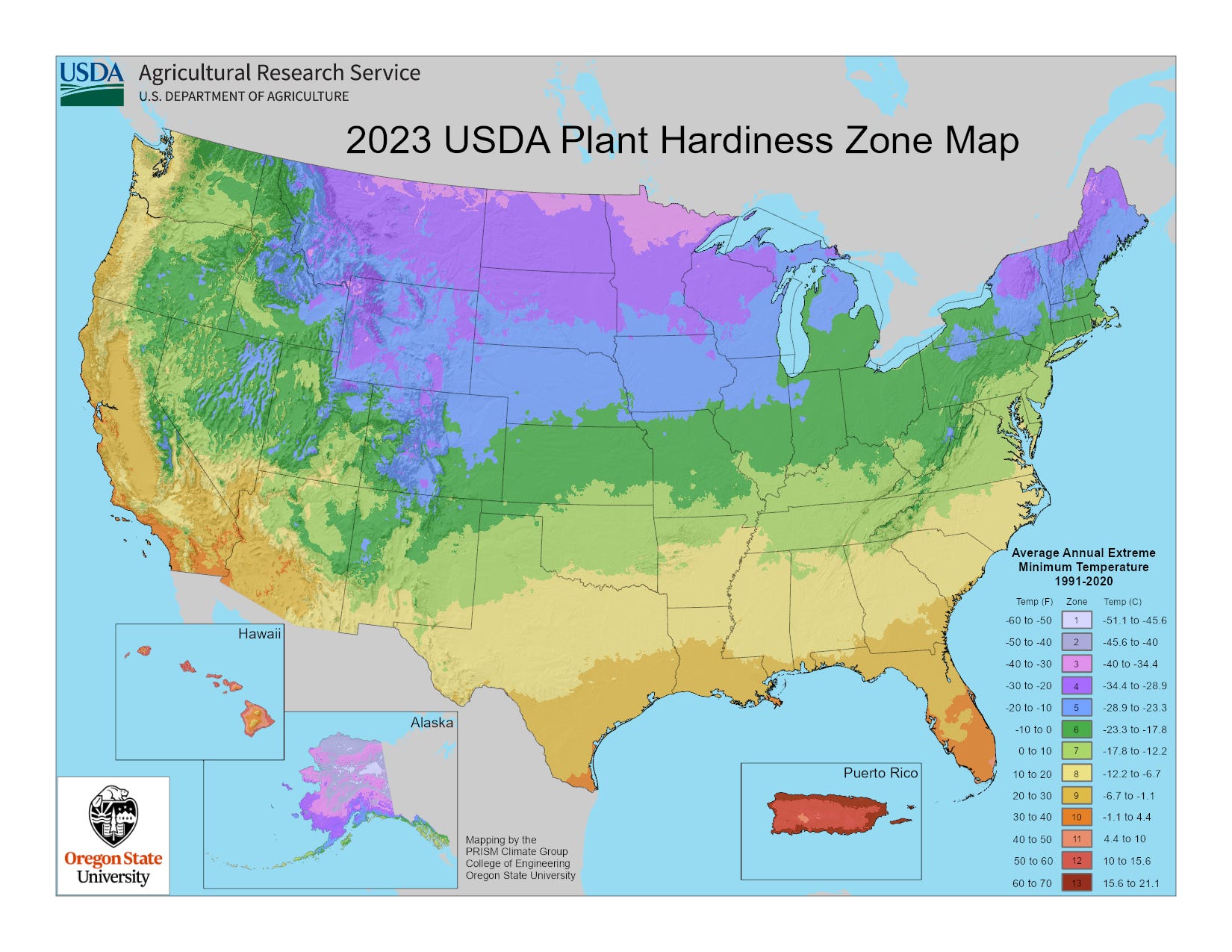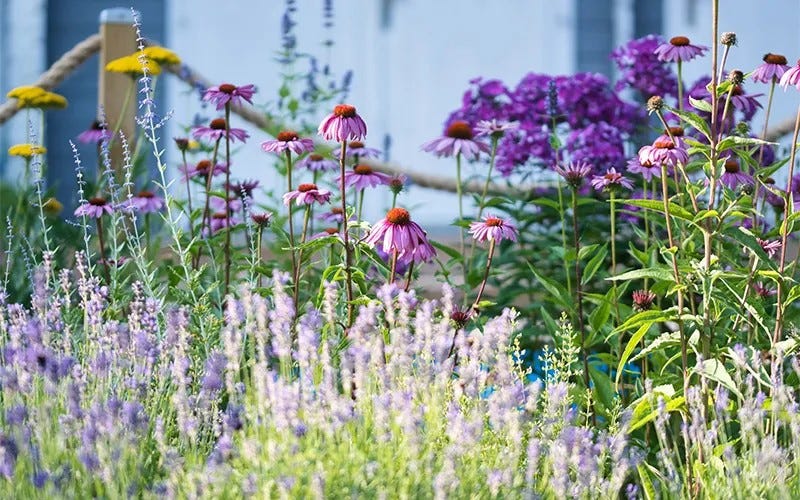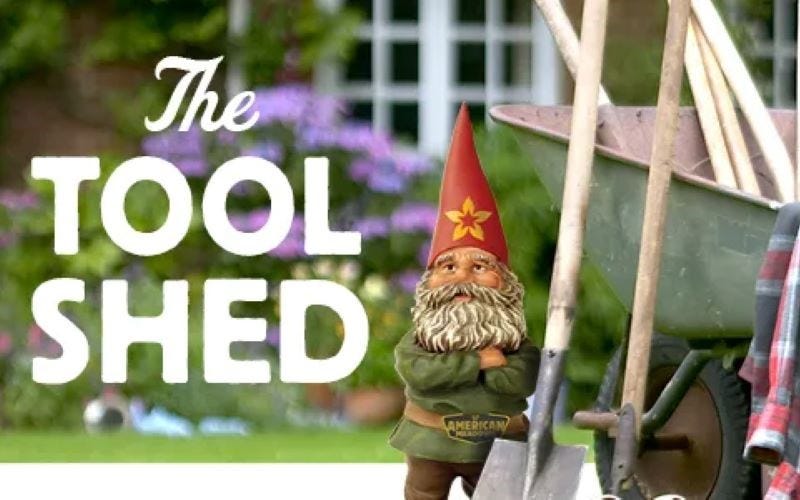The USDA Plant Hardiness Zone Map (shown above) is a tool that can help you find the right plants. Knowing your zone is critical before selecting plants because it allows you to purchase plants that will survive the extremes of the summer and winter months in your climate.
What Are USDA Zones?
Zones range from Zone 1 (coldest) to Zone 13 (warmest).
USDA zones are based on the average annual extreme minimum winter temperature. Each color represents average coldest temperature in 10°F zones. These zones provide a convenient way to communicate and compare the climates within the United States.
How To Find Your Zone
- Refer to the map above at a glance
- For more specific detail, you can enter your zipcode into our Zone Filter
- Or, click on the map above to enter your zipcode into the USDA Zone Filter
How To Use Hardiness Zones When Choosing Plants
- In late 2023, the USDA updated their Hardiness Zones based on 1991-2020 weather data - and they represent a trend in warming temperatures.
- USDA Zones are based on average temperatures, so it's possible that you may have an extreme cold snap, in which plants that have thrived in other years could be lost.
- Remember, USDA Zones help guide recommendations for hardiness, but they are just one of many factors to use when searching for the best plants for your yard. Light requirements, soil type, soil moisture, and average rainfall are all important factors.
- Every plant product page on our site has the zones it will survive in. When shopping at American Meadows, you can use our shopping filters to find plants for your zone.
Growing Zones & Hardiness Zones On Our Product Pages
Hardiness Zones
- We list the USDA Plant Hardiness Zones to indicate where a long-lived plant (a perennial or biennial) can survive the minimum winter temperatures. This is where the plant is considered "cold hardy."
- If there are no Hardiness Zones listed, then this plant can successfully survive the winters of the Growing Zones listed.
Growing Zones
- Sometimes we list Growing Zones on the product page that are outside of the plant’s Hardiness Zones.
- If a plant has Growing Zones outside of its Hardiness Zones, it can be grown with a little help from the gardener, treated as an annual, grown as a houseplant, or lifted and stored over the colder months.
For example, let’s look at Dahlia Hardiness Zones vs Growing Zones:
- Growing Zones = Zones 3-11
- Hardiness Zones = Zones 8-11 (lift in winter)
- This means that while Dahlias can be grown in Zones 3-11, they will only be winter hardy in Zones 8-11. The tubers can be dug and stored indoors over winter, or they can be treated as annuals and replanted every year.
Average First & Last Frost Dates For Your USDA Zone
Frost dates are important for gardeners to know, as they signal the start and end of the gardening season. These charts can help you estimate when to expect the first frost in fall, and the last frost in spring.
See our guide: Frost Dates By USDA Zone
The USDA Plant Hardiness Zone Map (shown above) is a tool that can help you find the right plants. Knowing your zone is critical before selecting plants because it allows you to purchase plants that will survive the extremes of the summer and winter months in your climate.
What Are USDA Zones?
Zones range from Zone 1 (coldest) to Zone 13 (warmest).
USDA zones are based on the average annual extreme minimum winter temperature. Each color represents average coldest temperature in 10°F zones. These zones provide a convenient way to communicate and compare the climates within the United States.
How To Find Your Zone
- Refer to the map above at a glance
- For more specific detail, you can enter your zipcode into our Zone Filter
- Or, click on the map above to enter your zipcode into the USDA Zone Filter
How To Use Hardiness Zones When Choosing Plants
- In late 2023, the USDA updated their Hardiness Zones based on 1991-2020 weather data - and they represent a trend in warming temperatures.
- USDA Zones are based on average temperatures, so it's possible that you may have an extreme cold snap, in which plants that have thrived in other years could be lost.
- Remember, USDA Zones help guide recommendations for hardiness, but they are just one of many factors to use when searching for the best plants for your yard. Light requirements, soil type, soil moisture, and average rainfall are all important factors.
- Every plant product page on our site has the zones it will survive in. When shopping at American Meadows, you can use our shopping filters to find plants for your zone.
Growing Zones & Hardiness Zones On Our Product Pages
Hardiness Zones
- We list the USDA Plant Hardiness Zones to indicate where a long-lived plant (a perennial or biennial) can survive the minimum winter temperatures. This is where the plant is considered "cold hardy."
- If there are no Hardiness Zones listed, then this plant can successfully survive the winters of the Growing Zones listed.
Growing Zones
- Sometimes we list Growing Zones on the product page that are outside of the plant’s Hardiness Zones.
- If a plant has Growing Zones outside of its Hardiness Zones, it can be grown with a little help from the gardener, treated as an annual, grown as a houseplant, or lifted and stored over the colder months.
For example, let’s look at Dahlia Hardiness Zones vs Growing Zones:
- Growing Zones = Zones 3-11
- Hardiness Zones = Zones 8-11 (lift in winter)
- This means that while Dahlias can be grown in Zones 3-11, they will only be winter hardy in Zones 8-11. The tubers can be dug and stored indoors over winter, or they can be treated as annuals and replanted every year.
Average First & Last Frost Dates For Your USDA Zone
Frost dates are important for gardeners to know, as they signal the start and end of the gardening season. These charts can help you estimate when to expect the first frost in fall, and the last frost in spring, so that you know when to plant in your garden or meadow.
See our guide: Frost Dates By USDA Zone
Identifying Microclimates In Your Yard
Your property is most likely not a “one size fits all” in terms of planting spots. Take a moment now to visualize all of the different microclimates you have. Some examples include:
- The North side of home or along a woodland edge could be an area with Full Shade, often with cooler temperatures.
- An open field or a south side of your home can get Full Sun with long, warm, sunny days.
- An east side of your house may get sun in the morning, but shade in the afternoon. (Part Sun / Afternoon Shade)
- A rocky hillside will have Quick Drainage and Sun
- A stream bed is likely to have wet, clay soil.
There can be many microclimates on one property, or from neighbor to neighbor. Identifying your unique growing conditions is important for properly selecting plants. For example, within the same USDA zone, the plants that will thrive next to a pond versus a rocky hilltop will likely be different plants.
- To do this, first recognize where you want to plant.
- Then analyze how much sunlight that location gets in a day. On our website, Full shade is usually 3 hours or less. Part shade / part sun is about 4-6 hours a day, and full sun is 6 hours +. Use the shopping filters for light requirements.
- Next, determine how dry or wet the location is; is it in a lowland spot that fills with water after a rain, or a dry hilltop? Use the shopping filters for soil type and moisture needs.
- From there, you can narrow down the plant palette you will work from.
- Make sure to look at the information provided for each plant online, or contact us for recommendations!
More Details From USDA
For in-depth details, visit the USDA Website. There, you can find a previous version of the map of USDA Zones from 2012-2023.



